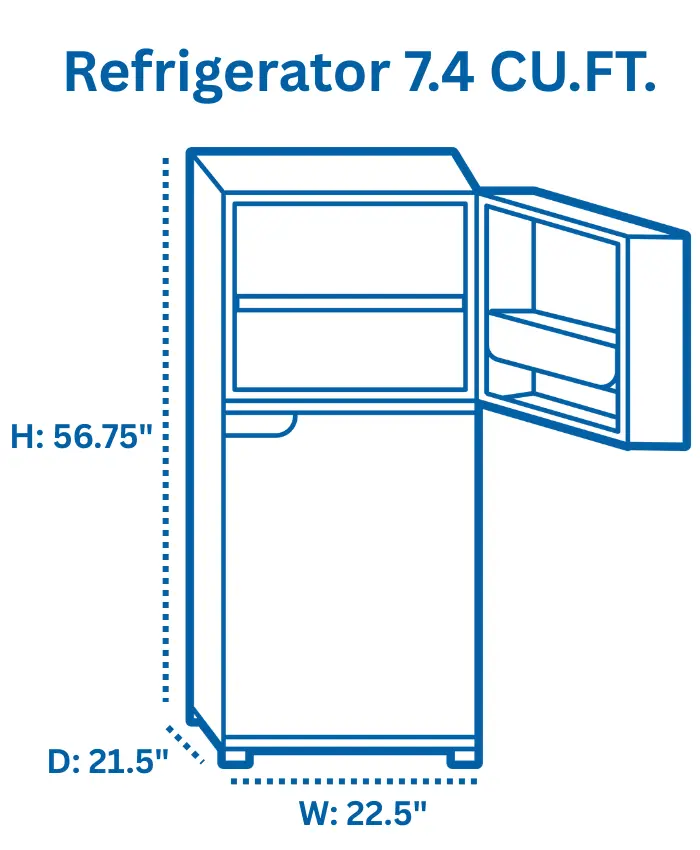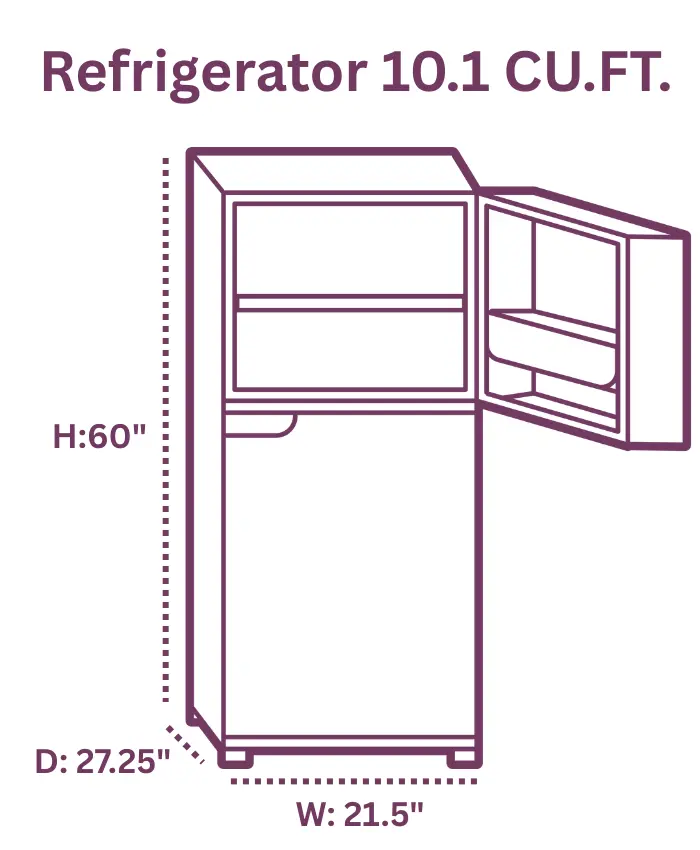Refrigerator dimensions vary by size. A 7.4 cu.ft. fridge is about H: 56.75″ x W: 22.5″ x D: 21.5″, ideal for small spaces. A 10.1 cu.ft. The fridge measures around H: 60″ x W: 21.5″ x D: 27.25″, perfect for apartments or extra storage.
Refrigerator Dimensions
| Capacity (cu.ft.) | Height | Width | Depth |
|---|---|---|---|
| 7.4 | 56.75″ | 22.5″ | 21.5″ |
| 10.1 | 60″ | 21.5″ | 27.25″ |
Why Refrigerator Dimensions Matter
A refrigerator that’s too big or too small can throw off your kitchen layout, utility bills, and daily convenience. When selecting a fridge, size is more than just an aesthetic choice. The right fit ensures easy access and prevents overcrowding, while too large or too small a fridge can disrupt your kitchen flow.
Clearance is another key factor—refrigerators need space to vent, and doors must open fully. Energy efficiency also varies by size. While smaller fridges often use less electricity, cramming them full can force them to work harder. Similarly, larger fridges may waste energy if not fully utilized.
Finally, your fridge’s capacity should match your lifestyle. A small fridge, like a 7.4 cu.ft. The model is perfect for individuals or couples, but a larger family may need a 10.1 cu.ft. or bigger fridge to store more food comfortably. Balancing these factors will ensure you choose the right fridge for both your space and needs.
Compact Refrigerators: 7.4 CU.FT.
A 7.4 cu.ft. A refrigerator is an ideal middle ground for small apartments, dorms, or as a secondary fridge.
Typically, a 7.4 cu.ft. The fridge has dimensions around 22.5 inches in width, 21.5 inches in depth, and56.75 inches in height. This compact size makes it perfect for spaces where a full-sized fridge would be too bulky.
These fridges are ideal for studio apartments, guesthouses, offices, or as additional storage in larger homes. With a 7.4 cu.ft. fridge, you’ll have enough room to store essentials like fruits, vegetables, drinks, and small frozen items. However, it’s not suitable for large families or heavy meal prep, as it can hold only a limited amount of groceries.
The primary advantage of a 7.4 cu.ft. The model is its space efficiency. It’s small enough to fit in tight spots, yet offers enough capacity for basic needs. On the downside, its limited storage space can be restrictive for those who cook frequently or have larger households.
Ultimately, balancing the convenience of a compact fridge with your storage needs is crucial. If you prioritize space-saving over large storage capacity, the 7.4 cu.ft. The refrigerator is a great choice.

Mid-Size Refrigerators: 10.1 CU.FT.
Stepping up from compact, the 10.1 cu.ft. the refrigerator offers a bit more space without demanding a full-sized footprint.
Typically, a 10.1 cu.ft. The fridge measures between 21.5 inches in width, 27.25 inches in depth, and 60 inches in height. This size provides more storage than a compact model while still fitting comfortably in smaller kitchens. It’s ideal for couples, small families, or shared housing where moderate food storage is needed without sacrificing too much space.
In this size range, you’ll find common features such as adjustable shelves, crisper drawers, and sometimes an ice maker. These fridges can store enough groceries for several days to a week, depending on the household.
The advantage of a 10.1 cu.ft. The fridge is the balance between capacity and size—it offers more room than a compact fridge but doesn’t overwhelm your kitchen. However, it may still be too small for larger families or those who buy in bulk. Additionally, it may take up more space than desired in a cramped kitchen.
Ultimately, a 10.1 cu.ft. The refrigerator strikes a sweet spot for those who need more storage without opting for a full-sized model.

Full-Size Refrigerators and Their Dimensions
Full-size refrigerators typically start around 18 cu.ft. and go all the way up to 30+ cu.ft., offering maximum storage for busy households.
These fridges are significantly larger than compact models, with typical dimensions ranging from 30 to 36 inches in width, 30 to 35 inches in depth, and 65 to 70 inches in height. They provide ample space for large families, frequent cooks, or those who entertain often.
Full-size fridges come in various configurations, including side-by-side, French door, and top/bottom freezer models. Side-by-side designs offer easy access to both the fridge and freezer sections, while French door models are known for their stylish, wide fridge compartments and bottom freezers. Top/bottom freezer models are traditional and often provide more freezer space.
When planning your kitchen space, it’s crucial to ensure you have enough clearance for door swings and ventilation. A larger fridge requires careful consideration of the surrounding space to maintain efficiency and ease of use. Additionally, full-size models consume more energy, so balancing size and energy use is essential.
Ultimately, full-size refrigerators are perfect for households that need substantial storage, but they come with the trade-off of requiring more space and a higher energy commitment.
How Refrigerator Capacity is Measured
When you see a refrigerator listed as 7.4 cu.ft. or 10.1 cu.ft., that number refers to the total internal volume of storage space. Cubic feet (cu.ft.) is a standard measurement used to indicate how much space a refrigerator offers. It’s calculated by multiplying the interior length, width, and height.
For example, a 7.4 cu.ft. The fridge may have more compact proportions, while a 10.1 cu.ft. The fridge provides a bit more storage. However, this internal volume isn’t always divided equally between the fridge and the freezer. Most models allocate more space to the fridge section, but the exact ratio can vary.
Some smaller models, for instance, may have a smaller freezer area, while larger fridges often provide more freezer capacity. It’s important to note that external dimensions can differ even for fridges with similar internal capacity. One model may have a taller design, while another is wider but shorter.
These differences can impact how the fridge fits in your kitchen, affecting both installation and convenience. Ultimately, understanding these measurements is essential in ensuring that the fridge you choose aligns with both your storage needs and available space.
Tips for Measuring Your Space
Before buying any refrigerator, accurate measurements of your kitchen space can save you from a frustrating delivery day. Start by measuring the height, width, and depth of the designated space. For height, consider the distance from the floor to the ceiling, leaving some room for ventilation.
For width, measure the total opening where the fridge will fit, and for depth, ensure the fridge will not protrude too far into the kitchen. Beyond these basic dimensions, it’s crucial to account for clearance space.
Refrigerator doors need enough room to open fully, so measure the space around the fridge, ensuring there’s at least a couple of inches on either side for smooth operation. Don’t forget to leave space behind the fridge for air circulation and proper ventilation.
Insufficient clearance can lead to inefficient cooling and higher energy bills. You should also consider nearby cabinetry or countertops. A fridge that’s too deep or wide can clash with these fixed elements, limiting its functionality.
If you’re choosing a larger model, check that it won’t obstruct any cabinetry or block pathways. In short, proper measurements ensure the fridge fits perfectly and functions efficiently, avoiding any costly installation headaches or energy inefficiencies.
Conclusion
Whether you’re outfitting a compact studio or upgrading your family kitchen, knowing refrigerator dimensions is key to a perfect fit. Matching fridge size to your lifestyle and available space is essential for convenience and efficiency. Use the provided dimensions as a guide to make an informed, practical choice.
FAQs
What size refrigerator is best for a small apartment?
For small apartments, a refrigerator between 7.4 cu.ft. and 10.1 cu.ft. is ideal. These sizes offer enough space for essentials without overwhelming the limited kitchen space. Compact fridges are space-efficient and work well in studio apartments, guesthouses, or as secondary fridges in larger homes.
How do I know if my kitchen has enough space for a full-size refrigerator?
To determine if your kitchen can accommodate a full-size refrigerator, measure the height, width, and depth of the designated space. Ensure there’s enough clearance for the fridge doors to open fully and for proper ventilation. Don’t forget to account for surrounding cabinetry or countertops to avoid obstructions.
What’s the difference between side-by-side and French door refrigerators?
Side-by-side refrigerators feature vertical compartments, offering easy access to both the fridge and freezer. French door models have a wide fridge section with two doors at the top and a bottom freezer, providing more storage flexibility and a sleek, modern look. French doors are often more energy-efficient as well.
Are smaller refrigerators more energy-efficient than larger ones?
Generally, smaller refrigerators use less energy. However, if a smaller fridge is overcrowded, it may have to work harder to cool, leading to higher energy consumption. In contrast, larger fridges, while needing more power to operate, can be more energy-efficient if used properly and not overstuffed.
Can I use a 7.4 cu.ft. refrigerator for a family of four?
A 7.4 cu.ft. A refrigerator is better suited for individuals or small households with minimal storage needs. For a family of four, you may need at least a 10.1 cu.ft, model or larger, depending on your cooking habits and grocery storage requirements. A larger fridge will offer better organization and sufficient space for fresh and frozen foods.